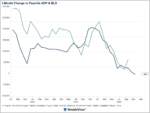 President Trump hinted at the end of last week that the Administration’s tax proposals would be aired in the next two or three weeks. This seems to be a signal of its inclusion in his address to both houses of Congress on February 28. This is not quite a State of the Union speech, but similar and precisely what Obama did in February 2009.
President Trump hinted at the end of last week that the Administration’s tax proposals would be aired in the next two or three weeks. This seems to be a signal of its inclusion in his address to both houses of Congress on February 28. This is not quite a State of the Union speech, but similar and precisely what Obama did in February 2009.
Taxes are complicated. Much of the discussion so far has been on the border adjustment, which is a tax on imports and a tax break for exports. If adopted it has far reaching implications, including but not limited to the potential challenge at the World Trade Organization and retaliatory action.
There has also been the suggestion to abolish the tax incentives for debt, which also have important implications for many businesses and the capital structure of corporations. It could also hit economic activity that is often funded by debt, such as private equity and mergers and acquisitions. There is also some discussion of how the global activity of multinational companies should be taxed.
Still, underlying much of the discussions is the belief that US corporate taxes are too high. Indeed, the margin Federal tax rates are 35%, and when state taxes are included, the marginal rates rises to 39.2%. The global average is near 25%. It is not a lie. Nor is it fake news. Nevertheless, it is grossly misleading.
Such claims focus on the statutory tax rate, not the effective tax rate, or what companies actually pay. The Congressional Research Service estimates that the average effective corporate tax rate is 27.1%, which is slightly below the OECD average of 27.7%.
Even this may overstate the case. Consider that the Citizens for Tax Justice found that GE, Boeing, Verizon, and 23 other Fortune 500 companies paid no Federal taxes between 2008 and 2012. More than 100 of the profitable Fortune 500 companies paid no taxes in at least one year in that five-year period. The advocacy group found that 288 of profitable Fortune 500 companies paid an effective tax rate of 19.4% between 2008 and 2012.
Leaving aside, the issue of how much taxes US corporations actually pay, if lower taxes boosted growth and/or employment they should be worth considering. However, this also does not look true. The Center for Effective Government found that 22 of the 30 profitable Fortune 500 companies that paid the highest corporate tax rate (30%+) in 2008-2012 increased payrolls by 200k. The 30 more profitable Fortune 500 companies that paid little or no taxes in that five-year period cut employment by a little more than 50k.
The impact of lower taxes on growth appears minimal at best. The Congressional Research Service estimates that a cut in the Federal tax schedule from 35% to 25% may boost growth by less than 0.2%. The reason why this may be so is that corporate tax rates are not the impediment to growth. As counter-intuitive as this may seem, US corporations and many large businesses around the world have more capital than they know what to do with. Isn’t that what is meant when capital is returned to shareholders in the form of stock buybacks and dividend increases? This is the central subject of my new book, Political Economy of Tomorrow.
The implication of this is if the effective US corporate tax rate is reduced, it may be good for equity owners. The US political and economic cycles have been generating tax reform every 20 years beginning with the 1920s, though skipping 1940 when the world was at war. Each was associated with a bull market in equities.
At the same time, corporate tax cuts can increase the disparity of wealth. The disparity of wealth (and income) can be a potent political force, as we have seen. A cut in corporate taxes could also and starve the government of revenue, which boosts US debt, and at a time it appears less attractive for foreign investors. The impact on government revenue should not be overstated (and that itself is a problem). Consider that in 1952, corporate taxes accounted for nearly a third of the Federal government’s revenue. By 2013, it had fallen to 10%.
Full story here Are you the author? Previous post See more for Next post
Tags: #USD,newslettersent,Political Economy of Tomorrow,SPY,Taxes











































